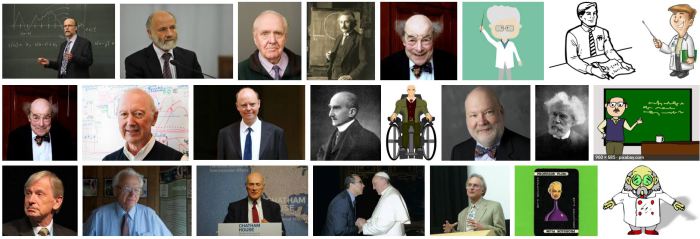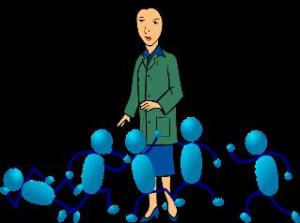
Picture a professor. Who comes to mind? These are the pictures I found in a Google Search for public domain images of a “Professor.” The first 22 above are a diverse group, at least in terms of their eyewear, neckwear, and hair (facial and otherwise). They are real and fictional, live and animated. And they are all white men.
This group of images captures an enduring cultural stereotype about who discovers and possesses scientific knowledge. It also captures an aspect of reality. Women are more likely to hold university faculty positions than ever before, yet they remain underrepresented in the highest prestige institutions, the highest paying disciplines and at the highest ranks. As of the academic year 2013-2014, men were about three times as likely as women to be full professors at degree-granting postsecondary institutions. As this image suggests, most of these men were white. Of all full professors, 57% were white men, while men of all other racial and ethnic groups made up 13%. White women were 25% of all full professors, women of all other racial/ethnic groups, 5%.
To explain gender disparities in the academy, many scholars argue that women faculty face a “chilly climate” in which subtle and overt discrimination accumulate to saturate the atmosphere of their workplaces. The problem with the metaphor is that it often does not match women’s own understanding of their experiences. For example, Laura Rhoton (2011) found that the women STEM faculty she interviewed rejected systemic accounts of discrimination, like the chilly climate, and minimized the importance of gender, seeing it as a distraction from their real work as scientists.
To make sense of the apparent paradox of the denial of gender in the midst of inequality, in this article I offer a synthetic theoretical perspective adapted from the work of Cecelia Ridgeway (2011) and Joan Acker (1990). I draw on interviews I conducted with 102 women faculty on thirteen campuses across the U.S. These women were associate and full professors, predominately in STEM disciplines.
I found that women sometimes denied and at other times emphasized the importance of gender. They described moments in which their gender became apparent to them in their interactions with colleagues and students, in policies and practices around workloads, and in assumptions about their appropriate roles.
When gender became salient in interactions, they often minimized its significance. When gender appeared in the form of policies and in assumptions about their appropriate roles, however, they were more likely to recognize it as important. Women described high service loads as one of the burdens they disproportionately faced, understood them as unfair, and definitely saw them as connected to gender. Indeed, the first picture of a woman in my Google image search for “professor,” which comes in at #33, captures this sense of being besieged with such requests, many (but by no means all) of which came from students. It also evokes an underlying cultural expectation about appropriate roles – also recognized by those I interviewed – that women serve others, while men, depicted in these images alone or in front of chalkboards covered in arcane hieroglyphics (or in one case with the Pope), serve only knowledge and exude professional authority.
Overall, I argue that for the most part women faculty do not experience their workplaces as oppressively chilly climates. This can be the case even when there is in fact considerable gender inequality – as when the ideal worker is male, bespectacled and balding. This does not mean women deny gender entirely, however. Understanding how multiple contexts within organizations shape experiences of gender inequality could be a first step in crafting meaningful strategies to promote equity.

No Comments